Year 1953 (1953) Created 1953 | ||
 | ||
Similar Wedding dress of Princess, Wedding dress of Princess, Coronation Chair, George VI and Queen Elizabeth, Wedding dress of Princess | ||
Queen Elizabeth II's coronation took place on 2 June 1953. Ordered in October 1952, it took eight months of research, design and workmanship to make the intricate embroidery of her coronation gown. It featured the floral emblems of the countries of the United Kingdom and those of the other states within the Commonwealth of Nations, including the English Tudor rose, Scots thistle, Welsh leek, Irish shamrock, Canadian maple leaf, Australian wattle, New Zealand silver fern, South African protea, lotus flowers for India and Ceylon, and Pakistan's wheat, cotton, and jute.
Contents

The gown, like the Elizabeth's wedding dress and other notable royal dresses of this period, was designed by Norman Hartnell. It was the Queen's wish that the coronation dress should be made of satin, like her wedding dress, with accentuation of regal elegance, but with no undue emphasis on shape. The gown now forms part of the Royal Collection.
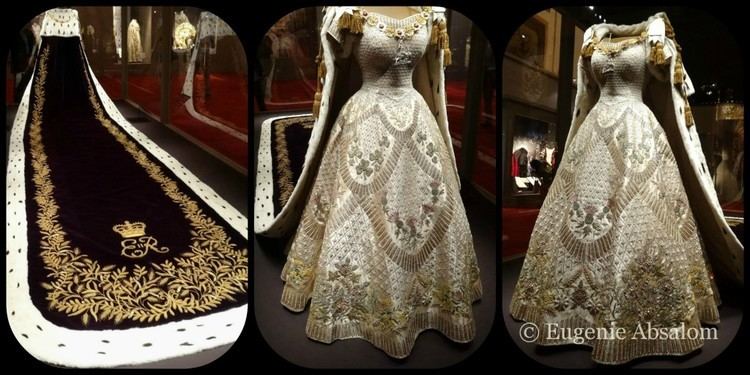
After the coronation, the dress was worn on several occasions such as when she opened the parliaments in New Zealand (1954), Australia (1954), Ceylon (1954), and Canada (1957).
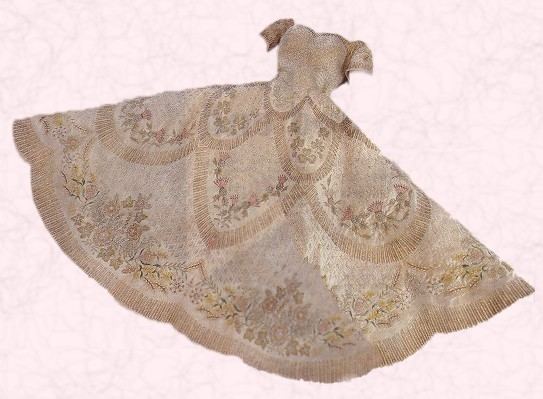
Design
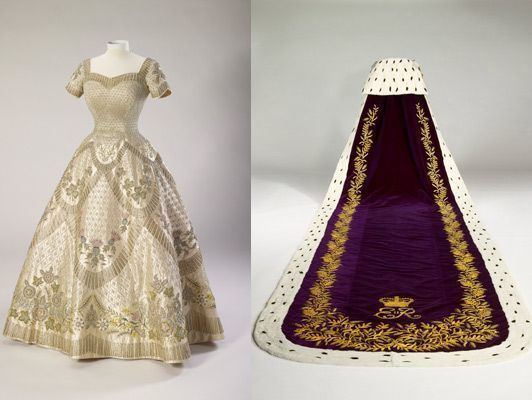
The dress was to be a historic masterpiece befitting the occasion, consequently one that would stand out. Like her bridal gown, the costume was designed by Norman Hartnell. Hartnell proposed at least eight different designs; the first, very simple, similar to that worn by Queen Victoria at her Coronation; the second, a modern slim-fitting sheath gown, embroidered in gold; the third, a crinoline style coronation dress of white satin, silver tissue and crusty silver lace; the fourth, white satin embroidered with Madonna and arum lilies and encrusted with pendant pearls; the fifth, a colourful design of violets, roses and wheat, the sixth, white satin with gold, silver and copper embroideries featuring branches of oak leaves with acorns; the seventh, the Tudor Rose of England, appliqued in gold tissue against white satin; and the eighth, similar to the seventh, but incorporating the floral emblems of Great Britain and the Commonwealth. The Queen favoured the last option if Hartnell introduced some colour and made some adjustments; a ninth design was then drawn up and presented to Elizabeth at Sandringham. Later Hartnell secretly added an embroidered extra four-leaved shamrock on the left side of her dress as an omen for good fortune.
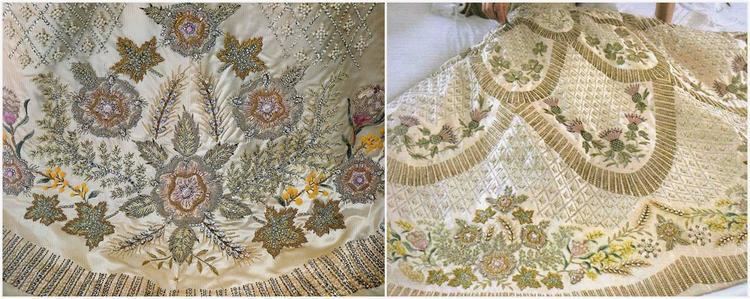
The final version featured a Tudor rose, embroidered in very pale pink silk, with pearls, gold and silver bullion, and rose diamante; the Welsh leek, embroidered in white silk with leaves of very pale green silk; the Scottish thistle, with pale mauve silk and amethysts and a calyx embroidered in reseda green silk, silver thread, and diamante dewdrops; the Irish shamrock, like the thistle, was embroidered in soft green silk, silver thread, bullion, and diamante. the Canadian maple leaf, made with green silk embroideries with a crystal vein and gold border; the silver fern of New Zealand, embroidered in straight stitches using soft green silk and veined in silver and crystal; the Australian wattle flower, made with a coarse mimosa yellow wool and green and gold foliage; the South African protea, embroidered in shaded pink silk, with green silk leaves and silver outlined petals; the lotus flower of India, made with seed pearls and diamante and mother of pearl embroidered petals; the Lotus flower of Ceylon, made with opals, mother of pearl, diamante, and soft green silk; and the three emblems of Pakistan: wheat, in oat-shaped diamante and fronds of golden crystal, cotton, made in silver with leaves of green silk, and jute, embroidered in green silk and golden thread.
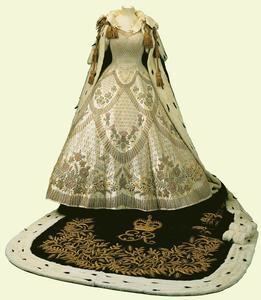
In addition to the gown, Hartnell also designed a plain white linen robe called a colobium sindonis, which initially covered the short-sleeved, low-neck gown. Attached to the shoulders was a crimson velvet mantle edged with ermine and featuring two rows of delicately embroidered gold lace and gold filigree. On the Coronation Day, the six maids of honour carried this robe behind the Queen.
Making
The dress, which was ordered in October 1952, took eight months of research, design and workmanship to make. Its intricate embroidery required many hours of diligent work by the dressmakers. The silk used to make the gown was obtained from Lady Hart Dyke's silk farm at Lullingstone Castle. The dress required the efforts of at least three dressmakers, six embroideresses and the Royal School of Needlework, responsible for the embroidery worked in gold bullion thread. The Robe of State of Crimson Velvet, which was attached to the shoulders of the gown, was hand-woven by Warners of Braintree, Essex, using Lullingstone Castle silk and made by Messrs. Ede and Ravenscroft of Chancery Lane, London.
